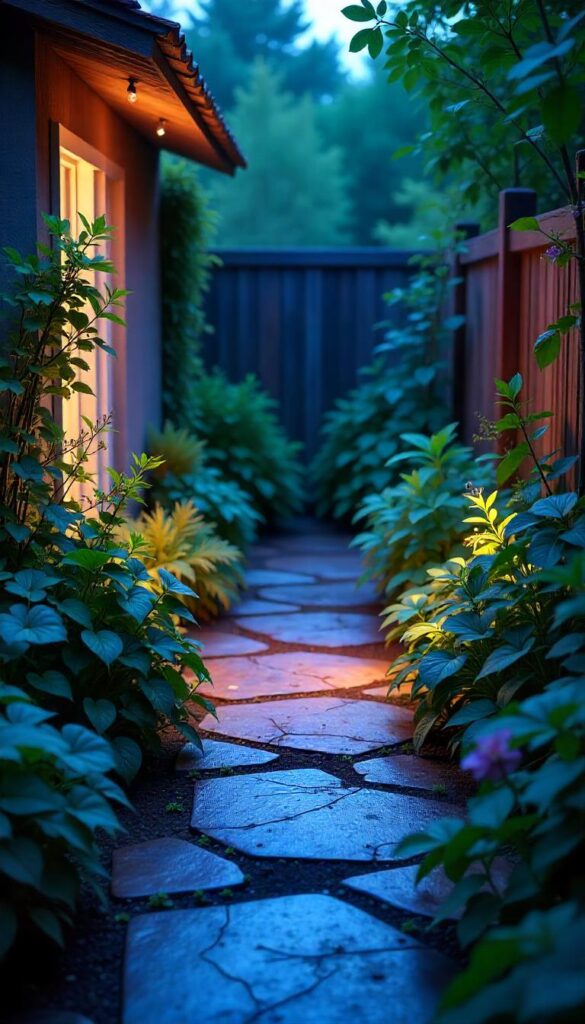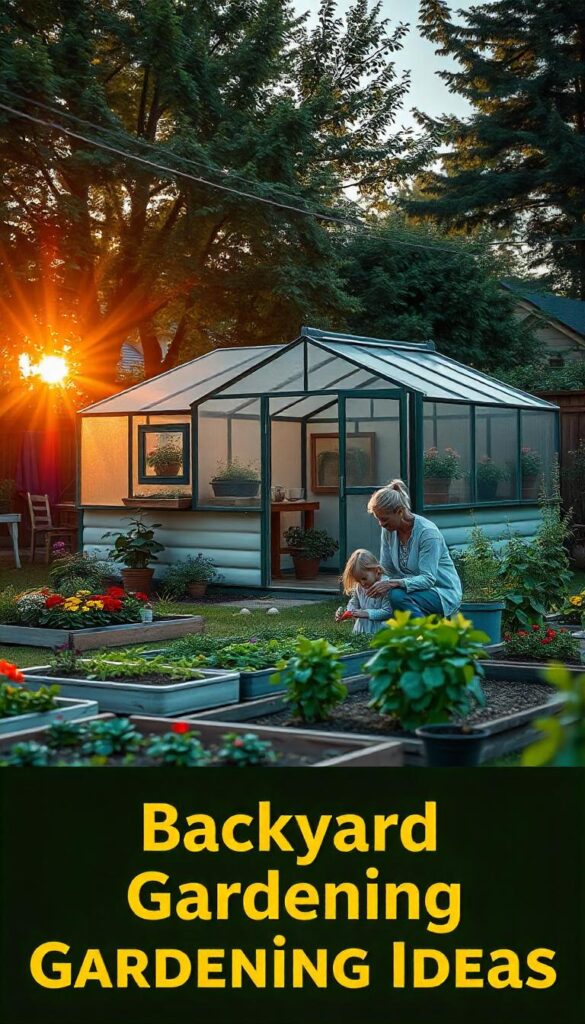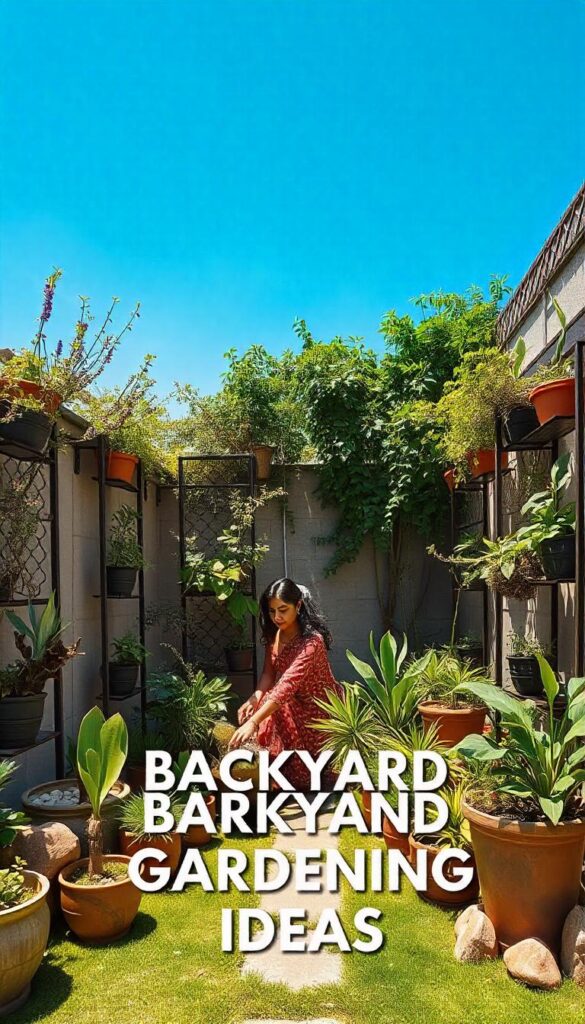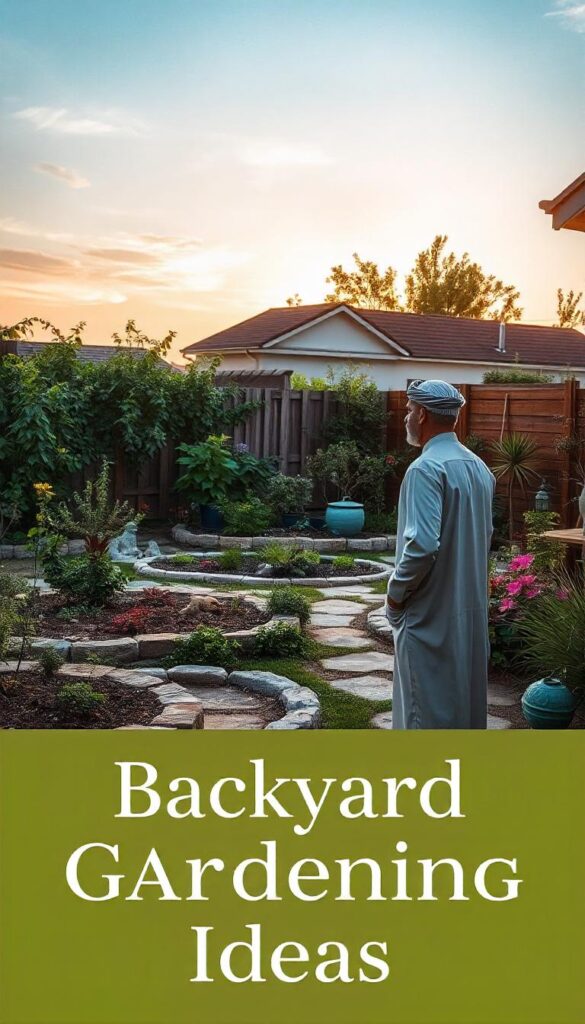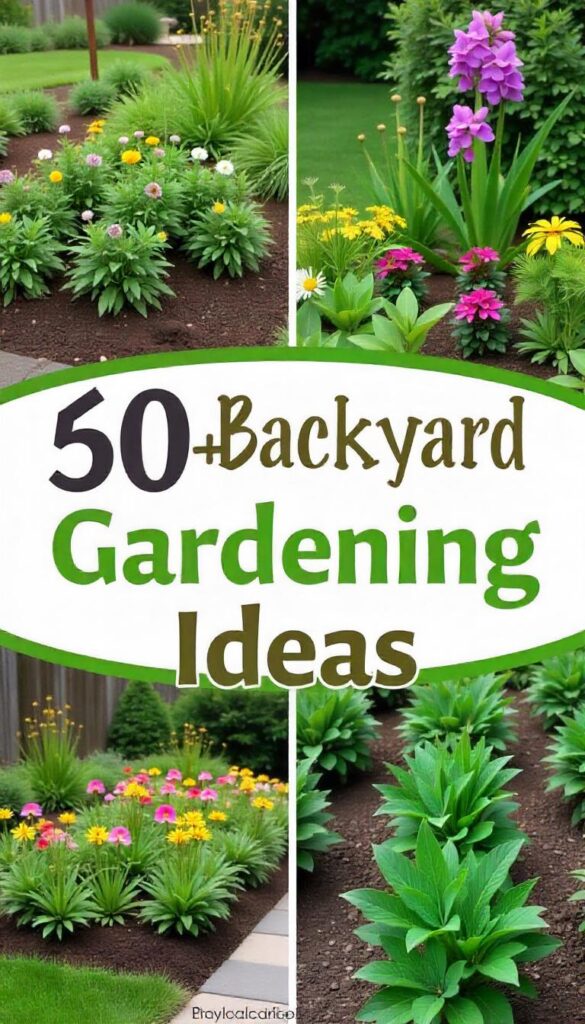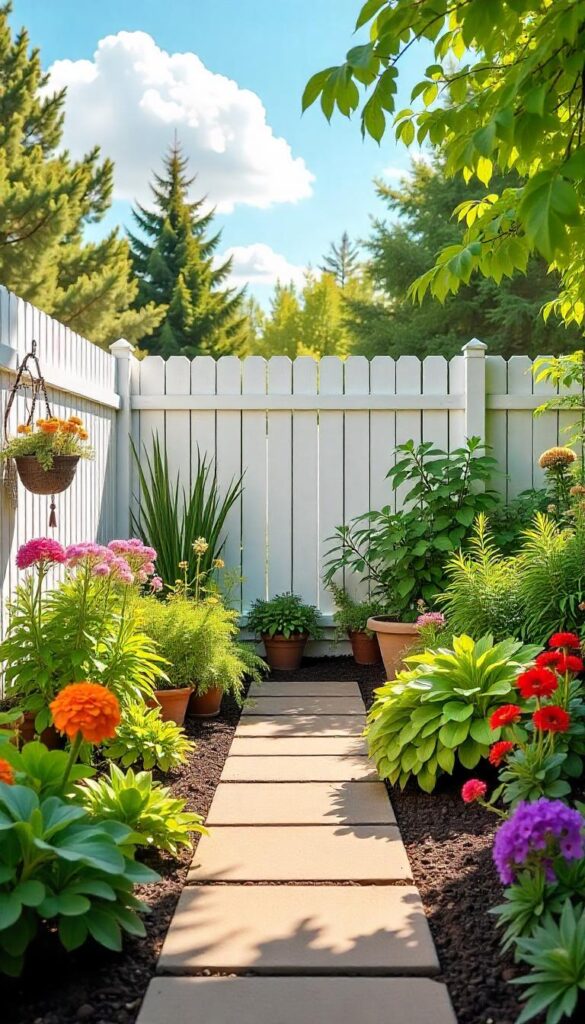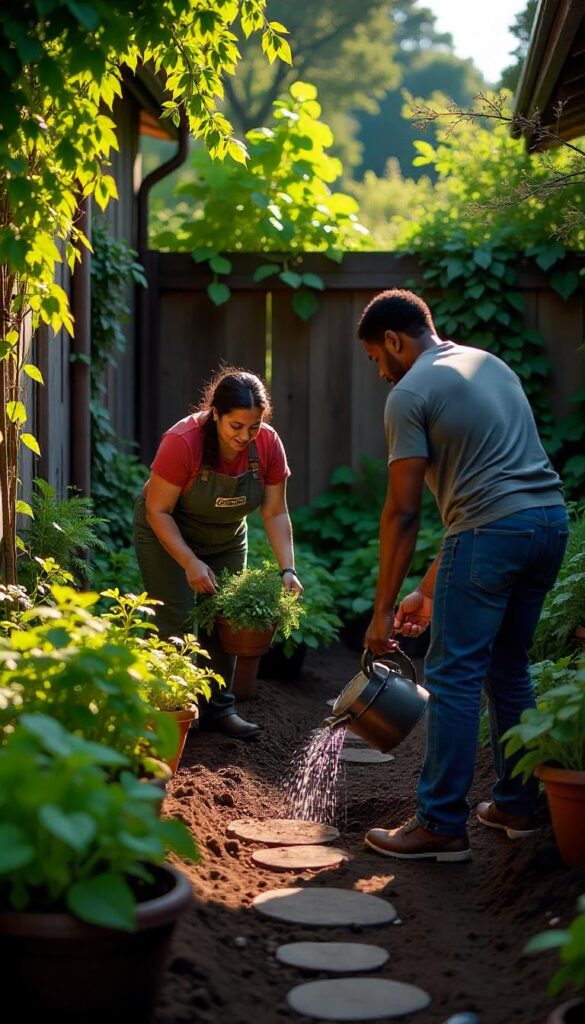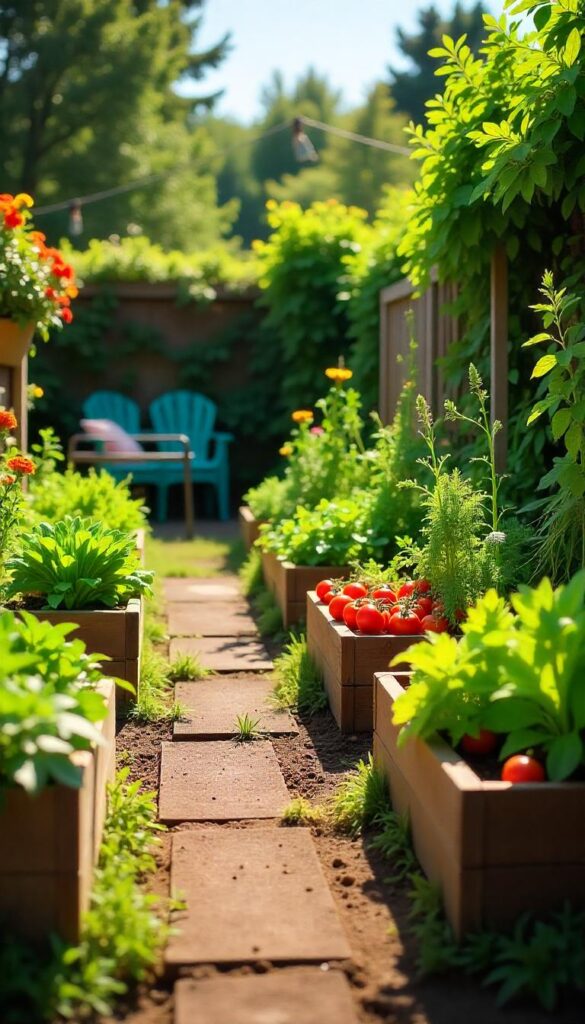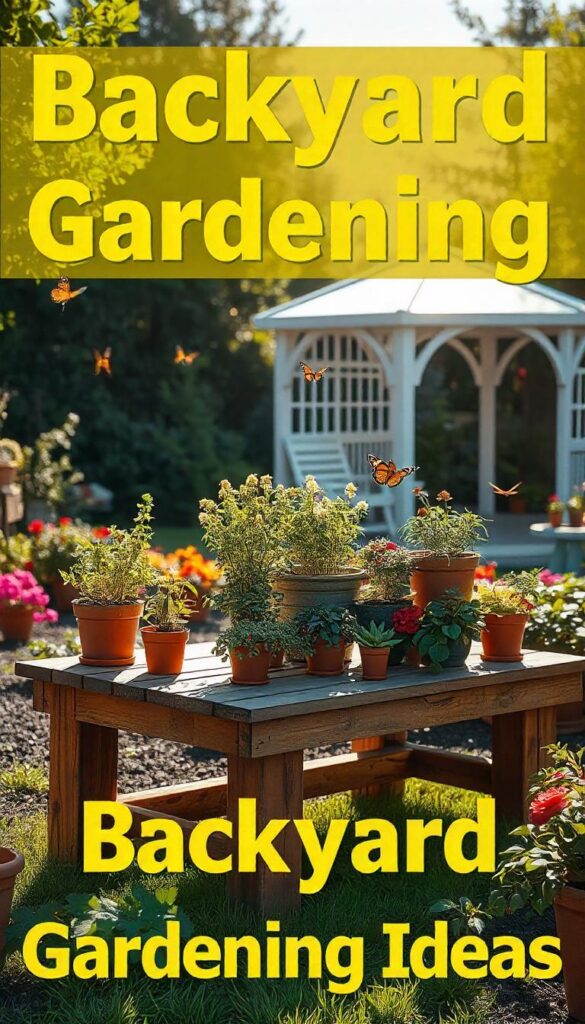Backyard gardening ideas offer a wonderful way to transform your outdoor space into a lush, green oasis while enjoying the therapeutic benefits of planting. From creating vegetable gardens and herb beds to cultivating flower gardens and even DIY vertical gardens, there are endless possibilities. You can start small with container gardens for herbs or flowers on a patio, or opt for raised garden beds to grow vegetables like tomatoes, carrots, and lettuce.
For a more eco-friendly approach, consider planting native plants that attract pollinators such as bees and butterflies, or creating a sustainable garden using composting and rainwater harvesting. Vertical gardens are ideal for small spaces, using trellises, plant walls, or hanging planters to maximize space. A garden path made of stepping stones or wood chips adds a charming touch, while a garden shed or cozy seating area can make your backyard a peaceful retreat. With thoughtful planning and creativity, your backyard can flourish into a beautiful and functional garden that enhances the beauty of your home.
Backyard Gardening Ideas
Creating a beautiful and functional backyard garden starts with choosing the right plants and trees. Here’s a detailed list of plants and trees to consider for your backyard gardening, categorized by types, uses, and special features.
Trees for Shade and Aesthetic Appeal:
- Oak Tree (Quercus spp.)
- Height: 50–80 feet
- Features: Provides excellent shade and can live for centuries. It has a strong trunk and produces acorns that attract wildlife.
- Best For: Large backyards with space for a tall tree.
- Maple Tree (Acer spp.)
- Height: 30–75 feet
- Features: Known for vibrant fall foliage, especially the red and sugar maples. Also produces sap that can be turned into maple syrup.
- Best For: A colorful addition in autumn and a large yard.
- Crape Myrtle (Lagerstroemia indica)
- Height: 15–25 feet
- Features: Blooms profusely in summer with bright pink, purple, red, or white flowers. It also has attractive bark and fall foliage.
- Best For: Small to medium-sized yards with hot, dry climates.
- Flowering Dogwood (Cornus florida)
- Height: 15–30 feet
- Features: Known for stunning spring blossoms and vibrant red foliage in the fall.
- Best For: Gardens that need a small ornamental tree with seasonal interest.
- Japanese Maple (Acer palmatum)
- Height: 15–25 feet
- Features: Gorgeous foliage with deep red, purple, or green leaves. Ideal for ornamental purposes and small spaces.
- Best For: Small gardens or as a specimen tree in landscaped areas.
Evergreens for Year-Round Greenery:
- Blue Spruce (Picea pungens)
- Height: 30–60 feet
- Features: A striking evergreen tree with silvery-blue needles, it provides a year-round aesthetic and is wind-resistant.
- Best For: Large gardens, windbreaks, or as a solitary specimen.
- White Pine (Pinus strobus)
- Height: 50–80 feet
- Features: A fast-growing evergreen with soft, long needles. Ideal for tall windbreaks and providing winter cover for wildlife.
- Best For: Large properties and as a background tree in woodland gardens.
- Holly Tree (Ilex aquifolium)
- Height: 15–30 feet
- Features: Known for its glossy leaves and bright red berries, it provides year-round visual interest.
- Best For: Hedgerows, privacy screens, and winter decorations.
Flowering Shrubs for Colorful Borders and Hedges:
- Hydrangea (Hydrangea spp.)
- Height: 3–10 feet
- Features: Large, round flower clusters in various colors like pink, blue, and white. It blooms from late spring to summer.
- Best For: Borders, hedges, or as a focal point in flower beds.
- Azalea (Rhododendron spp.)
- Height: 2–10 feet
- Features: Beautiful spring blossoms in pink, red, white, and purple hues. Prefers partial shade and acidic soil.
- Best For: Shade gardens or as a low-growing hedge.
- Lavender (Lavandula spp.)
- Height: 2–3 feet
- Features: Aromatic purple flowers and silvery-green foliage. Attracts pollinators like bees and butterflies.
- Best For: Herb gardens, borders, or containers.
- Boxwood (Buxus spp.)
- Height: 2–12 feet
- Features: A versatile evergreen shrub that is perfect for hedges, topiary, or decorative borders.
- Best For: Formal gardens or structured hedges.
- Lilac (Syringa vulgaris)
- Height: 8–15 feet
- Features: Fragrant clusters of purple, white, or pink flowers in late spring. Prefers full sun and well-drained soil.
- Best For: Flower beds, borders, or privacy screens.
Ground Cover and Low-Growing Plants:
- Creeping Thyme (Thymus serpyllum)
- Height: 3–6 inches
- Features: A fragrant, hardy herb that spreads quickly and is perfect for ground cover. It also attracts pollinators.
- Best For: Rock gardens, between stepping stones, or as lawn alternatives.
- Creeping Jenny (Lysimachia nummularia)
- Height: 4–8 inches
- Features: A low-growing perennial with round, bright green leaves that turn yellow in the fall.
- Best For: Ground cover, hanging baskets, or container gardening.
- Sedum (Sedum spp.)
- Height: 6–12 inches
- Features: Known for its succulent, drought-tolerant nature and vibrant blooms in late summer and fall.
- Best For: Rock gardens, dry beds, or as a border plant.
Edible Plants for a Productive Garden:
- Tomatoes (Solanum lycopersicum)
- Height: 3–6 feet (depending on variety)
- Features: Produce delicious, juicy fruits in various shapes and colors. Requires plenty of sunlight and well-drained soil.
- Best For: Raised beds, containers, or garden plots.
- Strawberries (Fragaria × ananassa)
- Height: 1–2 feet
- Features: Sweet, red berries perfect for fresh eating or making jams. Thrives in sunny spots and can be grown in hanging baskets.
- Best For: Raised beds, containers, or ground cover.
- Herbs (Basil, Mint, Oregano, etc.)
- Height: 6 inches to 3 feet
- Features: Easy-to-grow herbs with fragrant leaves perfect for cooking. Many are perennial and attract pollinators.
- Best For: Herb gardens, containers, or vegetable gardens.
- Blueberries (Vaccinium spp.)
- Height: 2–4 feet
- Features: Hardy bushes that produce sweet, nutritious berries in the summer. Prefers acidic soil.
- Best For: Edible landscapes or as an attractive shrub for gardens.
Flowering Perennials for Color and Texture:
- Echinacea (Coneflower)
- Height: 2–5 feet
- Features: Drought-tolerant and comes in vibrant colors like purple, pink, and orange. Attracts bees, butterflies, and birds.
- Best For: Wildflower gardens or as a border plant.
- Daylilies (Hemerocallis spp.)
- Height: 1–4 feet
- Features: Hardy, low-maintenance flowers that bloom profusely in various colors.
- Best For: Borders, flower beds, or ground cover.
- Shasta Daisy (Leucanthemum x superbum)
- Height: 1–3 feet
- Features: Bright, cheerful white flowers with yellow centers. Grows well in full sun and well-drained soil.
- Best For: Cottage gardens or sunny borders.
- Black-eyed Susan (Rudbeckia hirta)
- Height: 2–3 feet
- Features: A perennial that blooms bright yellow flowers with dark centers. Attracts pollinators and looks great in groups.
- Best For: Wildflower gardens or perennial beds.
Tropical and Exotic Plants for a Lush Look:
- Banana Plant (Musa spp.)
- Height: 4–12 feet
- Features: Large, dramatic leaves with the possibility of producing edible bananas. Prefers warm, tropical climates.
- Best For: Tropical garden designs or as a focal point in large gardens.
- Canna Lily (Canna indica)
- Height: 2–5 feet
- Features: Tropical-looking plants with large, vibrant flowers in shades of red, yellow, or orange.
- Best For: Bold, colorful borders or containers.
Climbing Plants for Vertical Interest:
- Clematis (Clematis spp.)
- Height: 6–20 feet
- Features: Beautiful flowering vine that blooms in a variety of colors, from deep purple to pink and white.
- Best For: Trellises, arbors, or fences.
- Wisteria (Wisteria sinensis)
- Height: 20–30 feet
- Features: Known for its cascading clusters of bluish-purple flowers in spring. Prefers full sun and a sturdy support structure.
- Best For: Pergolas, trellises, or fences.
By selecting a variety of these plants and trees, you can create a lush, productive, and visually stunning backyard garden. Consider your climate, space, and personal preferences when planning your garden to ensure its success.
How to decorate Backyard Garden
Backyard gardening is an enjoyable and rewarding way to grow your own plants, vegetables, fruits, or even create an ornamental space for relaxation. Whether you’re starting a small vegetable patch or a flower garden, the process involves careful planning and dedication. Here’s a detailed guide on how to get started with backyard gardening.
Step 1: Assess Your Space
Before diving into gardening, it’s essential to evaluate your available space. Determine:
- Size of the area: How much space do you have for gardening? This will help you decide whether you want to grow a few pots of flowers, a full vegetable garden, or a mix of both.
- Sunlight exposure: Observe how much sunlight your backyard receives throughout the day. Most plants, especially vegetables, need 6–8 hours of direct sunlight to thrive. Choose your garden spot accordingly.
- Soil quality: Test your soil’s texture, pH, and nutrient levels. You can buy a soil test kit from a garden store or send a sample to a local agricultural extension. Good soil is key for healthy plants.
- Water supply: Ensure there’s a convenient water source nearby for consistent watering.
Step 2: Plan Your Garden
Planning is crucial to make sure everything grows in harmony and thrives. This step involves:
- Decide what to grow: Think about your climate, the amount of space you have, and your personal preferences. Common backyard garden options include vegetables, fruits, herbs, and flowers. Consider growing plants that complement each other (e.g., companion planting) and provide seasonal interest.
- Vegetable garden: Tomatoes, peppers, lettuce, beans, cucumbers, and carrots are good choices for beginner gardeners.
- Herb garden: Basil, mint, rosemary, oregano, and thyme grow well in small spaces and can be planted in containers or raised beds.
- Flower garden: Annuals like sunflowers, marigolds, and petunias provide vibrant colors, while perennials like coneflowers, lavender, and daylilies offer long-lasting beauty.
- Garden layout: Sketch out the arrangement of your plants. If you’re growing vegetables, plant the tallest ones (e.g., corn or beans) toward the back or in the center of your garden, with shorter plants like lettuce or herbs near the front.
- Raised beds: These can be particularly useful for improving drainage and soil quality. Raised beds also help reduce weeds and make gardening easier on the back.
- Container gardening: If space is limited, consider container gardening. This works well for herbs, small vegetables, and flowers.
Step 3: Prepare the Soil
Healthy soil is the foundation of a thriving garden. Here’s how to prepare your soil for planting:
- Clear the area: Remove any grass, weeds, or debris. If you’re planting vegetables, it’s essential to eliminate these because they can compete for nutrients.
- Amend the soil: Add compost, well-rotted manure, or organic matter to improve soil fertility, texture, and drainage. If you have clay soil, amend it with sand or organic matter to help break it up and improve drainage. For sandy soil, add organic matter to help retain moisture.
- Tilling: Lightly till or rake the soil to a depth of about 3–4 inches. If you’re using raised beds, this step may not be necessary.
- Level the soil: After tilling, smooth out the surface of the garden bed to ensure even planting.
Step 4: Choose Your Plants
When selecting plants, it’s essential to choose varieties suited for your region and growing season. Some plants require specific conditions, so research their needs before planting. Here are some plant categories:
- Annuals: These plants complete their life cycle in one growing season (e.g., marigolds, impatiens). They need to be replanted each year.
- Perennials: These plants come back year after year, and their care is generally less demanding once established (e.g., coneflowers, lavender).
- Herbs: Many herbs like basil, thyme, rosemary, and mint can thrive in a small backyard or container garden.
- Vegetables and Fruits: Choose crops that grow well in your climate, such as tomatoes, cucumbers, squash, strawberries, and peppers.
Step 5: Planting Your Garden
Now that you’ve prepared your soil and selected your plants, it’s time to plant.
- Timing: Ensure you plant after the last frost in your area, especially for frost-sensitive plants like tomatoes and peppers. Refer to your area’s gardening calendar for optimal planting times.
- Planting depth: Follow the instructions for each plant. Most seeds should be planted at a specific depth—generally, 2–3 times their size. If planting transplants, dig a hole large enough to accommodate the root ball and plant at the same depth as it was in the container.
- Spacing: Leave enough space between each plant to allow for proper growth and air circulation. This will help prevent disease and overcrowding.
Step 6: Watering and Mulching
Proper watering is essential to plant health, but it’s important to avoid overwatering.
- Watering: Water your plants deeply and regularly, especially during dry periods. Early morning is the best time to water, as it prevents water from evaporating and gives plants time to dry before evening.
- Mulching: Apply a layer of mulch around your plants. Mulch helps retain moisture, suppress weeds, and regulate soil temperature. Organic mulches like wood chips, leaves, or straw are excellent choices.
Step 7: Care and Maintenance
Regular care and maintenance will help your garden thrive. This includes:
- Weeding: Regularly pull out weeds that compete for water and nutrients. Use mulch to reduce the number of weeds.
- Fertilizing: Feed your plants with compost or a balanced fertilizer to ensure they get the nutrients they need for healthy growth.
- Pruning: Prune dead or damaged plants and flowers to encourage new growth and remove diseases. Trim overgrown plants to maintain shape and promote airflow.
- Pest control: Keep an eye out for pests. Use natural pest control methods such as neem oil, insecticidal soap, or companion planting to deter unwanted critters.
Step 8: Harvesting
When your plants are ready, it’s time to harvest! Follow guidelines for each plant, as timing can affect flavor and texture. For example:
- Vegetables: Pick veggies when they are ripe, but not overripe. For tomatoes, pick them when they’re fully colored. For leafy greens, harvest the outer leaves first, allowing the inner leaves to keep growing.
- Herbs: Harvest herbs by cutting the top leaves or stems. Be sure not to cut more than a third of the plant at once to avoid stressing it.
Step 9: Seasonal Care
As the seasons change, you’ll need to adjust your care routine:
- Spring and Summer: Focus on planting, watering, and managing pests. Harvest your crops and enjoy the vibrant blooms.
- Fall: Start preparing your garden for winter. You can still plant some cool-weather crops or bulb flowers for the next spring.
- Winter: Depending on your region, your garden may go dormant. Winterize by covering tender plants or bringing pots indoors.
Final Tips for Successful Backyard Gardening:
- Start small: If you’re a beginner, start with a few plants and gradually expand.
- Be patient: Gardening requires time and effort. Plants need time to grow, so don’t get discouraged.
- Stay consistent: Regularly check for pests, water needs, and general health of your plants.
By following these detailed steps, you’ll soon enjoy the fruits of your labor—whether it’s beautiful flowers, fresh vegetables, or a peaceful green retreat in your own backyard.
List of Plants and Trees for Backyard Garden
Creating a beautiful and vibrant backyard garden involves selecting the right plants and trees that complement your space, climate, and aesthetic preferences. Here is a detailed list of plants and trees you can consider for your backyard garden:
1. Trees for the Backyard
Flowering Trees:
- Dogwood (Cornus florida): Known for its beautiful spring flowers, dogwoods come in various colors such as pink, white, and red. It thrives in partial shade and well-drained soil.
- Japanese Cherry Blossom (Prunus serrulata): Famous for its stunning pink blossoms, this tree offers a spectacular spring display. It requires full sun and well-drained, slightly acidic soil.
- Magnolia (Magnolia spp.): Known for its large, fragrant flowers in shades of white, pink, and purple, magnolias can be deciduous or evergreen, depending on the variety. They thrive in full sun to partial shade.
Shade Trees:
- Maple (Acer spp.): A popular shade tree with beautiful autumn foliage. Varieties such as Red Maple and Silver Maple provide quick growth and dense shade.
- Oak (Quercus spp.): Oaks are sturdy, long-lived trees that provide excellent shade. Varieties like the Red Oak or White Oak are perfect for larger spaces.
- American Sycamore (Platanus occidentalis): This tree is ideal for large yards and provides dense shade. It features distinctive peeling bark and large, broad leaves.
Evergreen Trees:
- Colorado Blue Spruce (Picea pungens): Known for its silvery-blue foliage, this evergreen tree is a great addition to any backyard for year-round color and structure.
- Eastern Red Cedar (Juniperus virginiana): This fast-growing tree offers dense, aromatic foliage and is often used as a windbreak or privacy screen.
- Leyland Cypress (Cupressus × leylandii): A popular choice for hedging, this evergreen tree grows quickly and forms a tall, dense screen, ideal for privacy.
2. Shrubs for the Backyard
Flowering Shrubs:
- Hydrangea (Hydrangea spp.): Known for its large, showy flowers that change color depending on soil acidity. Hydrangeas are great for partial shade and rich, well-drained soil.
- Azalea (Rhododendron spp.): Azaleas are small, compact shrubs that produce beautiful, vibrant flowers in spring. They prefer partial shade and acidic soil.
- Lilac (Syringa spp.): With its fragrant flowers in shades of purple, pink, and white, lilacs bloom in spring and are perfect for a sunny location.
Evergreen Shrubs:
- Boxwood (Buxus spp.): Boxwoods are versatile and can be shaped into hedges, borders, or topiaries. They provide year-round greenery and are low-maintenance.
- Holly (Ilex spp.): Known for its bright red berries and glossy, dark green leaves, holly is an excellent shrub for adding color during the winter months.
- Juniper (Juniperus spp.): Junipers come in various shapes and sizes, from ground cover varieties to tall trees. They are hardy, drought-tolerant, and ideal for low-maintenance landscapes.
Fragrant Shrubs:
- Gardenia (Gardenia jasminoides): Known for its sweet, fragrant white flowers, gardenias thrive in full sun to partial shade and prefer acidic, well-drained soil.
- Jasmine (Jasminum spp.): Jasmine shrubs provide an amazing fragrance with their small, white or yellow flowers. They require full sun and well-drained soil.
- Mock Orange (Philadelphus spp.): Mock orange shrubs offer fragrant, white flowers in late spring or early summer. They thrive in full sun and adaptable soil.
3. Perennials for the Backyard
Flowering Perennials:
- Lavender (Lavandula spp.): Known for its purple flowers and soothing fragrance, lavender is drought-tolerant and thrives in full sun and well-drained soil.
- Coneflower (Echinacea purpurea): These daisy-like flowers with purple, pink, or white petals attract pollinators and bloom throughout the summer in full sun.
- Black-eyed Susan (Rudbeckia hirta): Featuring bright yellow petals and a dark center, these cheerful flowers bloom from summer to fall and are perfect for sunny spots.
Ground Covers:
- Creeping Thyme (Thymus serpyllum): A fragrant and low-growing herb, creeping thyme makes an excellent ground cover for sunny areas, adding texture and color to your landscape.
- Creeping Jenny (Lysimachia nummularia): This ground cover has bright green leaves and produces small yellow flowers. It thrives in both sun and partial shade.
- Pachysandra (Pachysandra terminalis): A fast-growing ground cover that thrives in the shade, Pachysandra provides dense foliage and is perfect for shady garden areas.
Grasses and Ferns:
- Fountain Grass (Pennisetum alopecuroides): This ornamental grass adds movement and texture to your garden with its graceful, arching blades and soft, feathery flower heads.
- Maiden Grass (Miscanthus sinensis): Known for its elegant form, Maiden Grass features tall, feathery plumes in late summer to fall and can thrive in sunny locations.
- Autumn Fern (Dryopteris erythrosora): This fern offers vibrant, reddish-orange fronds in spring that mature to a lush green. It’s great for shady, moist areas.
4. Edible Plants for the Backyard
Vegetables:
- Tomatoes (Solanum lycopersicum): A backyard garden staple, tomatoes thrive in full sun and provide delicious fruits in a variety of colors and flavors.
- Lettuce (Lactuca sativa): Lettuce is easy to grow in cooler temperatures, making it perfect for spring or fall gardens. It grows well in partial shade.
- Bell Peppers (Capsicum annuum): These colorful vegetables require full sun and fertile, well-drained soil. They are great for containers or raised beds.
Herbs:
- Basil (Ocimum basilicum): A fragrant herb often used in cooking, basil thrives in full sun and well-drained soil. It’s perfect for containers, raised beds, or garden borders.
- Mint (Mentha spp.): Mint is a fast-growing herb that loves moisture and partial shade. It can be invasive, so it’s best to plant it in a container or confined space.
- Rosemary (Rosmarinus officinalis): Rosemary is a hardy herb with fragrant, needle-like leaves. It thrives in full sun and can be used in cooking or as a decorative plant.
Fruit Trees:
- Apple (Malus domestica): Apple trees come in various sizes, making them ideal for backyard gardens. They need full sun and well-drained, fertile soil.
- Peach (Prunus persica): Peaches require a sunny location with plenty of warmth and well-drained, fertile soil. They produce delicious fruits in late summer.
- Lemon (Citrus limon): Lemon trees are perfect for warmer climates and need full sun to produce their zesty fruits.
5. Vines and Climbers for the Backyard
- Clematis (Clematis spp.): Known for its stunning, star-shaped flowers in a range of colors, clematis is perfect for trellises, fences, or arbors.
- Wisteria (Wisteria spp.): Wisteria vines produce cascades of fragrant, lavender or white flowers in the spring. They thrive in full sun and require strong supports.
- Ivy (Hedera helix): Ivy is an evergreen vine that can quickly cover walls, fences, or garden structures. It’s low-maintenance and provides a lush, green backdrop year-round.
Choosing the Right Plants
When selecting plants and trees for your backyard garden, consider the following factors:
- Climate: Ensure that the plants you choose are suitable for your climate zone.
- Soil Type: Test your soil to determine whether it’s acidic, alkaline, or neutral and select plants accordingly.
- Sunlight: Know whether your garden gets full sun, partial shade, or full shade to choose plants that thrive in those conditions.
- Space: Consider the mature size of the plants and trees to avoid overcrowding in smaller yards.

